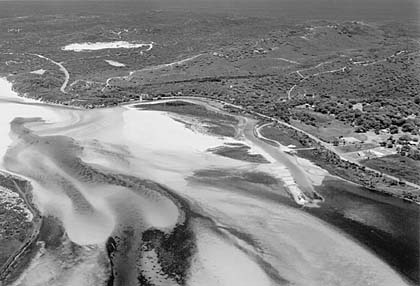
Wilson Inlet sandbar
How pollution affects waterways
The effects of pollution can vary from place to place. Damage can be local or disturb the ecology of an entire estuary. The impact of pollution depends on the type and amount of pollution and on the characteristics of the waterway itself, especially how well an estuary is flushed with sea water when the tides go in and out. Water exchange between an estuary and the sea is limited by the size and depth of the estuary's inlet channel and often by a seasonal sand bar at the mouth. An estuary with a deep, open tidal movement of sea water in and out is less likely to have lasting harm from pollutants. But an estuary where the movement of sea water in and out is limited may suffer quite a lot. The Swan River Estuary receives nutrient inputs similar to those of the Peel-Harvey Estuary, which could result in eutrophication. But so far the Swan River Estuary has had less harmful effects than the Peel-Harvey because the Swan has good tidal exchange (the sea water moves easily up the river and the fresh water moves easily downstream) through the channel at Fremantle. The Dawesville Channel, however, may swing the balance in favour of the Peel-Harvey because it improves water flow into and out of the estuary.
Most of the south-western estuaries have good water quality. The waterways are generally safe to swim in, have abundant plant and animal life and usually offer good catches of fish, crabs and prawns.
The greatest threat to the South-West's estuaries appears to be an excessive input of nutrients from changes in land use in the surrounding catchments. Some estuaries have rising nutrient levels while others are already showing signs of environmental damage. These are mentioned below.
The Peel-Harvey Estuary at Mandurah has had blooms of large green algae (called simply `weed') since the early 1970s. The weed accumulates in the shallows and along the shoreline, where it rots with an unpleasant odour. Spring growths of the toxic blue-green algae Nodularia have turned the water green almost every spring since 1978. Fish catches decline during the Nodularia bloom, and oxygen levels in the water drop, often causing mass death of bottom-living animals. Many of the other fish in the estuary eat the bottom-dwellers, and if there are less bottom-dwellers, other fish will starve and die, too.
The Dawesville Channel was constructed in 1994 to help the Peel-Harvey Estuary flush better. It's expected that more water flowing into and out of the estuary through the channel will flush out the nutrients and reduce algae growth.
A limited study of trout caught in Gooralong Brook, a tributary of the Serpentine River (which flows into the Peel Inlet), contained levels of DDT (a pesticide) up to six times greater than the recommended level for human consumption.
The Swan River Estuary has been noted for its good water quality for a river flowing through a capital city. In recent years, however, there have been microalgal blooms in the upper reaches. The river may be on the verge of serious damage caused by increasing population pressures. As more and more people live near the river, there are polluting effects from lawn fertilisers, roadway run off, industrial drainage and other pollutants.
The Leschenault Estuary at Bunbury is another estuary which still has good water quality, but like the Swan River it has reached the point where an increase in nutrient inputs could upset the estuary's balance. Weed is as abundant as in Peel Inlet, but it doesn't usually cause a problem that people complain about because the algae doesn't often blow up onto beaches near residential areas. It can, however, still cause problems for our environment.

Wilson Inlet sandbar
| For more about this see section 9 |
Wilson Inlet at Denmark has a sandbar at its mouth and is seasonally closed from the sea. It is suffering the effects of eutrophication because of excessive algae growth and heavy build-up of rotting organic material on the western shores. The sandbar is usually breached early in the year to prevent flooding of agricultural land and to flush the nutrients from the inlet.